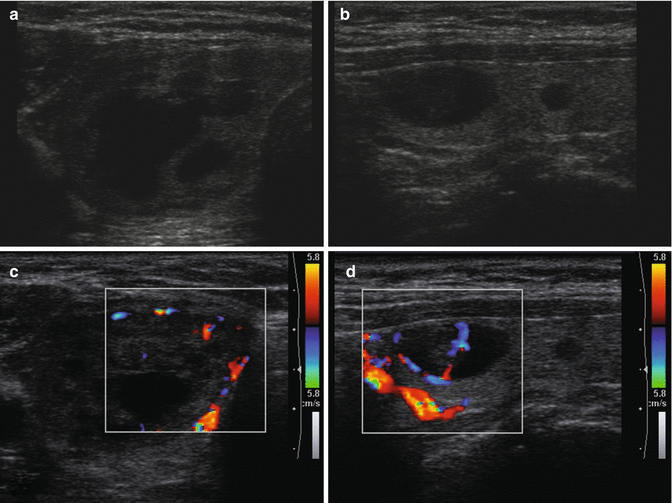Fig. 7.1
Axial computed tomography (a), ultrasonography (b), and color Doppler ultrasonography (c) images in a 70-year-old male patient with hyperthyroidism. Computed tomography (a) showed a large nodule (diameter of 4.5 cm) in the right thyroid lobe (arrow). The thyroid nodule was hypoechoic and inhomogeneous at ultrasonography (b) with low intranodular blood flow (c). These morphological findings were not specific for hyperfunctioning thyroid nodules

Fig. 7.2
Scintigraphic findings in the same patient of Fig. 7.1. Thyroid scan with 99mTcO4 − (a) showed a large hyperfunctioning thyroid nodule in the right thyroid lobe with functional suppression of the remaining thyroid parenchyma (b). These findings are confirmed by scintigraphy with 123I performed for dosimetric purpose. After radiometabolic treatment with 131I, euthyroid status was reached and posttreatment thyroid scan with 99mTcO4 − showed homogeneous uptake in the thyroid gland (c)

Fig. 7.3
Ultrasonography (a, b) and color Doppler ultrasonography (c, d) images in a 66-year-old female patient with hyperthyroidism. Ultrasonography showed two hypoechoic and inhomogeneous nodules in the right thyroid lobe (a, b) with increased blood flow (c, d). These ultrasonography findings are not specific for hyperfunctioning thyroid nodules

Fig. 7.4
Scintigraphic findings in the same patient of Fig. 7.3. Thyroid scan with 99mTcO4 − (a) showed two hyperfunctioning thyroid nodules in the right thyroid lobe with functional suppression of the remaining thyroid parenchyma (b). These findings were confirmed by scintigraphy with 123I performed for dosimetric purpose. After radiometabolic treatment with 131I, euthyroid status was reached and posttreatment thyroid scan with 99mTcO4 − showed homogeneous uptake in the thyroid gland (c)
< div class='tao-gold-member'>
Only gold members can continue reading. Log In or Register to continue
Stay updated, free articles. Join our Telegram channel

Full access? Get Clinical Tree


